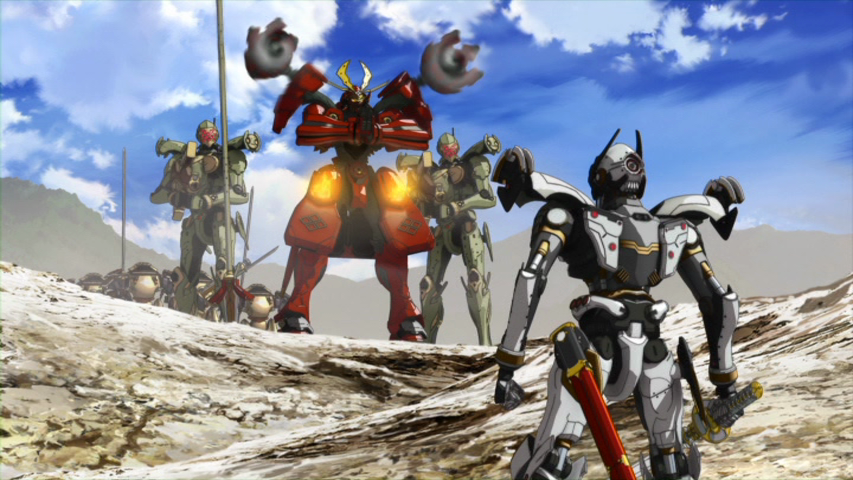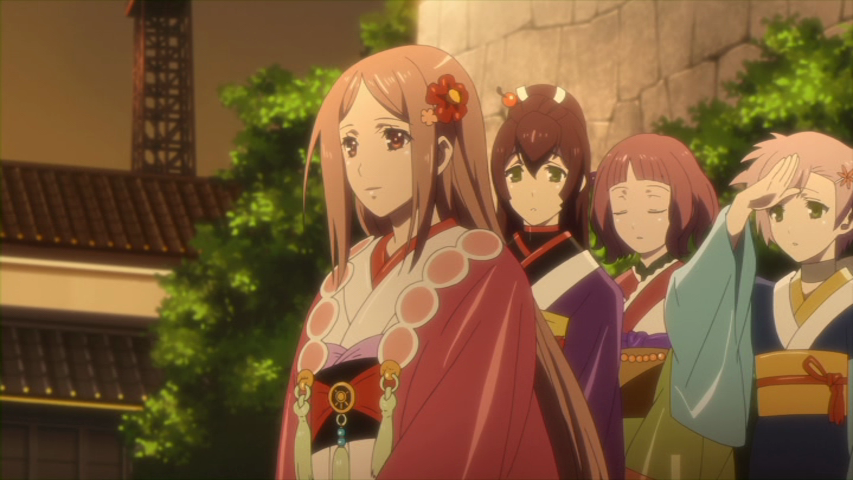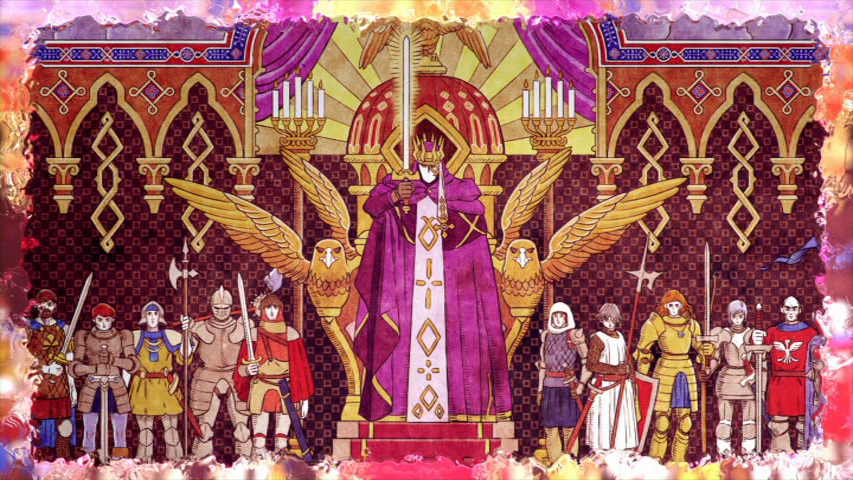Nobunaga the Fool Part 1 (Episodes 1-13)

“Will you find your own way or will you be pulled by the winds of the Dragon Vein Vortexes?” Leonardo da Vinci to Jeanne Kaguya d’Arc
Jeanne Kaguya d’Arc (the one who hears voices) is whisked away on a space ship by Leonardo da Vinci and Admiral Magellan from their home, the Western Star, to the Star of the East. There she sees in the carefree young warlord Oda Nobunaga (nicknamed ‘the Fool’) the potential to be her long dreamed-of Saviour King, the one who has haunted her dreams. But as if Nobunaga doesn’t have enough troubles dealing with the other warlords vying to take control, back on the Star of the West (ruled over by King Arthur) one Julius Caesar has also set out to conquer the Eastern Star and to gather the Sacred Treasures that will enable King Arthur to find the Holy Grail. Or something.

‘Samurai warriors battle giant robots in a war of epic proportions.’
So proclaims the poster for this release – and that’s exactly what it is. No more, no less. Famous Japanese warriors (mostly) from the Warring States Era line up against famous historical figures from a far wider time period representing the West: King Arthur, Leonardo da Vinci (who plays a leading but ambiguously manipulative role) Julius Caesar, Brutus, Magellan, Hannibal… and Jeanne Kaguya d’Arc (Kaguya, one assumes, after Princess Kaguya who travelled from the moon to earth in the Japanese legend). Leonardo da Vinci crosses to the Eastern Star, bringing Jeanne, technological wizardry and a set of Tarot cards which he makes Jeanne draw from time to time and which seem to influence the events (and the episode titles as well): ‘The Fool’, ‘The Lovers’, ‘The Wands’ etc.) rather as, in Vision of Escaflowne, a ‘fate alteration machine’ and heroine Hitomi’s pendant influence what happens to the protagonists. Although forced to dress as a young male retainer, Ranmaru, Jeanne shows little of the feisty warrior nature you’d expect from ‘the Maid of Orleans’, blushing like a love-smitten schoolgirl around her crush, Nobunaga. Eventually, Nobunaga finds himself facing a formidable rival: Julius Caesar, who has allied himself with some of Nobunaga’s enemies and also has designs on Nobunaga’s sweet-natured sister: Princess Ichi.

Original Creator Shoji Kawamori has a truly formidable and amazing CV: having created The Vision of Escaflowne and Aquarion, not to mention many of the Macross outings and designed mecha for innumerable other anime series, including Transformers and the Nirvash for Eureka Seven. It was difficult, therefore, given his impressive creative background, not to expect great things from Nobunaga the Fool – and he certainly delivers mecha in plenty. But in spite of all the energetic battles, with and without mecha, something is missing. The whole premise (famous historical figures from East and West battle for supremacy) must have seemed a blast at the time but somehow the people fail to come to life, remaining two-dimensional in the least complimentary sense of the word. A whole bundle of ingredients are thrown into the mix: fan service; mecha; attempts at humour that misfire; magical jewels; prophecies… And the ghost of Escaflowne haunts proceedings but without the musical genius of Yoko Kanno and Hajime Mizoguchi to enhance the drama, not to mention the flaccid pacing and some tired, predictable plotting, it’s a lacklustre affair. The characters are not endearing; Nobunaga often comes across as an arrogant, petulant adolescent with a big mecha, and Jeanne Kaguya d’Arc mopes around, sighing (inexplicably) over him.

The Sentai US dub is one to avoid. The dub script is awkward and even unintentionally funny in places. And the performances!? Scott Gibbs is, to be fair, not really any worse than most of his fellow actors in the dub but I expected better from the voice of Mikorin in Nozaki-kun! Of the original cast, Mamoru Miyano seems, at least, to be having fun in his swashbuckling portrayal of Nobunaga.

The music, by experienced composer Masayu Yokoyama, is perfectly adequate (although I wonder if he was required to work with a temp track taken from Escaflowne for the battle sequences?) He’s done far better with Arakawa under the Bridge, Mobile Suit Gundam: Iron-Blooded Orphans and many more. The best music/image moments come with the stirring OP#1: “FOOL THE WORLD” by Minori Chihara and the beautiful concept artwork (harking back to Aquarion) for the ED which hints at an early vision of what the story might have been rather than the pedestrian version they ended up with.

In Summary
It’s a little sad when the best one can find to say about an anime series is that the artwork in the ED is truly gorgeous! But Nobunaga the Fool is disappointing, especially given the talents of the team working on it.

